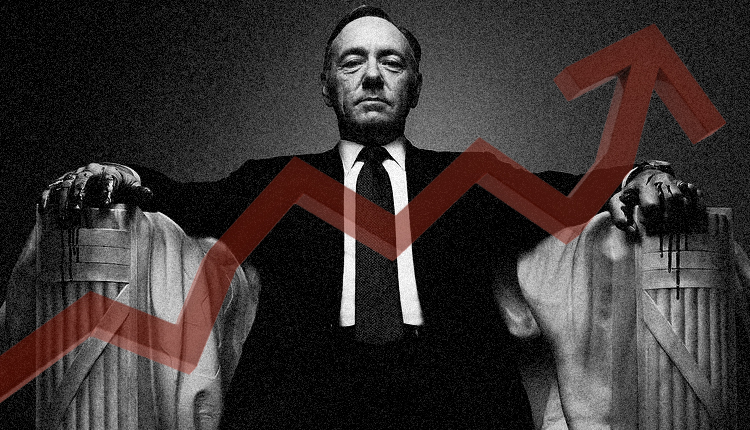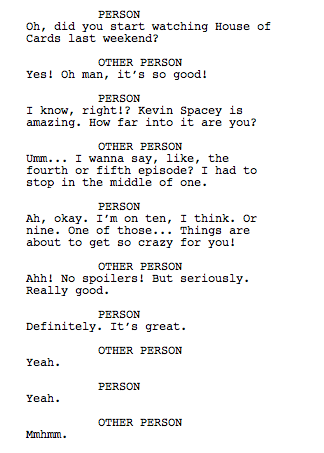Year on the Binge

Netflix Originals and Why the Water Cooler Still Might Matter
In 2013, I worked from home. The entire calendar year.
It was, at times, an adjustment: the wonky hours, the cabin fever, the post-lunch revelations that pants might be called for. But there was one home office side effect I hadn’t counted on: the television. My God, the astounding, incessant, embarrassing amount of television zero commutes and lunch hour in your living room allows you. Do you know me? Have you recommended I watch a TV show in the past five years? Chances are, in 2013, I finally watched it (still not Dexter and Lost, though, you crazies).
In some ways, it felt fortuitous: 2013 was a pretty kick-ass year for TV. Established prestige shows like Mad Men, Boardwalk Empire, and Sons of Anarchy churned out stellar seasons. Import series like Top of the Lake, The Returned, and The Fall made impressive debuts. Even curiosities like Sleepy Hollow, Agents of SHIELD, and Hannibal were worth a gander. Sometimes even multiple ganders.
But the biggest television happening of the year was the rise of Netflix Originals. You know the ones: Eli Roth’s Hemlock Grove. Jenji Kohan’s Orange is the New Black. The infinitely awaited revival of Arrested Development. And of course, the flagship series, Kevin Spacey’s House of Cards, which just returned last month for a second smarmy season. All of them high-profile. Star-studded. And, if you ask Netflix, successful. The company keeps its numbers under wraps, but the headlines were everywhere: this whole Netflix Originals thing could be the end of the ol’ boob tube as we know it. And we watched the heck out of it.
So it’s likely that, at some point in 2013, you had a conversation like this:
This kind of riveting discourse happened because Netflix Originals aimed for a phenomena the company itself helped popularize: Binge Viewing. We’ve all done it. One episode turns into two, two into three, and before you know it, it’s 2:39am and you’re down a whole bag of Flamin’ Hot Cheetos and an amount of wine you’re definitely going to feel in the morning (editors note: a 2010 Cab is a recommended pairing here).
Binge viewing is fun. Cathartic. Convenient. And Netflix knows it. To capitalize on these perks, they made the decision to release each of its original shows an entire season at a time. When, how, and at what pace you watch them is a completely customized experience tailor-made for You™.
It’s a ballsy move for Netflix, but a calculated one. The company not only used Big Data to help select its projects, but also inform its all-at-once distribution model. That’s right, all our deepest hopes and dreams can now be Moneyball’d into hour long increments and streamed directly into our living rooms for $7.99 a month, all via some simple head counts. Yay, the future?

While it’d be hard to argue that this distribution model hasn’t generated viewership, it’d be even tougher to prove that it hasn’t been at the cost of something less quantifiable. Something that can’t just be crunched by a computer or Nate Silver’d into fruition. Because while Netflix was keen to enable me to watch this new kind of TV, and you to watch it, they forgot about us watching it. “Us” as in the pretty well-documented fact that watching television can be a culturally communal experience.
They forgot about the water cooler.
It sounds like an antiquated term, but the power of the water cooler has reigned over TV audiences for a quite a while. Lucy and Ethel in the candy factory. The death of Colonel Blake. Who Shot JR? Bob Newhart’s dream. Yadda yadda yadda. Ellen coming out. The maybe-sorta death of Tony Soprano. WE WERE ON A BREAK. These pop culture moments became touchstones not just because they aired, but because we experienced them together. And for the most part, we still do. The water cooler never went away. We just call it something different now.
Because, Jesus, what is the Internet if not a giant, bubbling hub where fans come together to cooperatively experience, dissect, bitch about, and celebrate EVERYTHING, television included? Blogs and op-eds and recap series and Twitter and Tumblr and Reddit and message boards are just teeming with whatever aired last night, premiere predictions, crazy storyline theories, our favorite moments captured in looping gifs, and so, so much more. It’s all kind of awesome actually and has only come about because of two reasons: 1.) Scripted TV now often reaches a level of sophistication actually worthy of ardent analysis and fervor, and 2.) it is aired on a viewing schedule we are still happy to roughly adhere to.
So, for all the high fives that went around about Netflix Originals last year, they were drawn in stark contrast against some of the other TV goings-on in 2013. Saul and Carrie’s crazy asylum ploy. Ted Mosby finally meeting his wife. Brian Griffin becoming roadkill. The Bob Benson theories. The Red Wedding. When I went to activate my new iPhone last Summer, the Verizon woman’s first question wasn’t about my data plan or accessories, it was “Can you believe what Walter White did last night?” And I couldn’t.
One might argue that Netflix Originals aren’t fair game here, that these popular moments all came from well-established shows with huge followings. But remember True Detective’s righteous 6 minute tracking shot in its fourth episode that broke the Internet? Okay, well now try and imagine it buried four hours deep into eight hours content we can all start watching whenever the mood strikes us. Would it have still been as awesome? Yes. Would it still have made the same impact, gotten the same props? Would we still have been as excited? No goddamn way.
Because beyond the “everyone’s-on-the-wrong-damn-page-at-this-book-club” experience binge viewing confounds fans with, it isn’t the most flattering way to enjoy your favorite shows. On the eve of the Arrested Development drop, showrunner Mitch Hurwitz warned against gorging on the newest season of the show. After watching the new AD season, it’s easy to see why: it’s one of most complex and ambitious sitcom treatments… probably ever? And it’s difficult to pick up the subtle notes of absurdity, continuity, and poignancy when we’re diving head-first, jaw unhinged, into its trough of episodes.

Hurwitz goes on to describe what we all kinda already know: that, beyond robbing a show’s audience of anticipation, debate, reflection, and camaraderie, binge viewing compresses the viewing experience into a flimsy, and often irretrievable file that’s flung to the back our brain’s hard drive. We know it’s there and if we sort of liked it or not, but the details of the experience are immediately .zipped away. For a lot of shows, that’s actually fine (and Christ, no one has the time to be a super-fan of everything), but for the ones we cherish, or the ones we could cherish, this is sort of an issue. Binge viewing makes “what happens next” a priority over “what just happened.” More and more often, we’re seeing a lot of thought and artistry going into all that stuff that just happened and, given a moment’s digestion, it could even make what happens next even better.
And that’s the weird contradiction we in Netflix Nation find ourselves in the middle of, because this binge watching trepidation is not a knock on the company or its shows, it’s more of a lament. HoC, OITNB, and AD are all shows worthy of the kind of enthusiasm and dissection their broadcast counterparts enjoy. And by keeping its hands off the TV creative process, Netflix is attracting more and more talent to its roster, promising even more quality content we maybe don’t want to mindlessly gobble up. Marvel is getting into the Netflix business and so are the Wachowskis. If studios and networks are the square, rigid parents of creators, Netflix keeps sliding in like the cool older sibling who’s just come home from college, ready to offer TV its first cigarette. And that’s pretty rad.
But if Netflix’s current smorgasbord model holds strong and changes TV… will it change us, too? Is this our a big, sad kumbaya moment before we curl up in our individual cells, armed with Cheetos, booze, and zero pants, endlessly shoveling Kevin Spacey into our faces in ominous silence? Is this how Netflix wants us? Like we’re all working from home!?
At the very least, it does sound like an easy way to get a head count.

